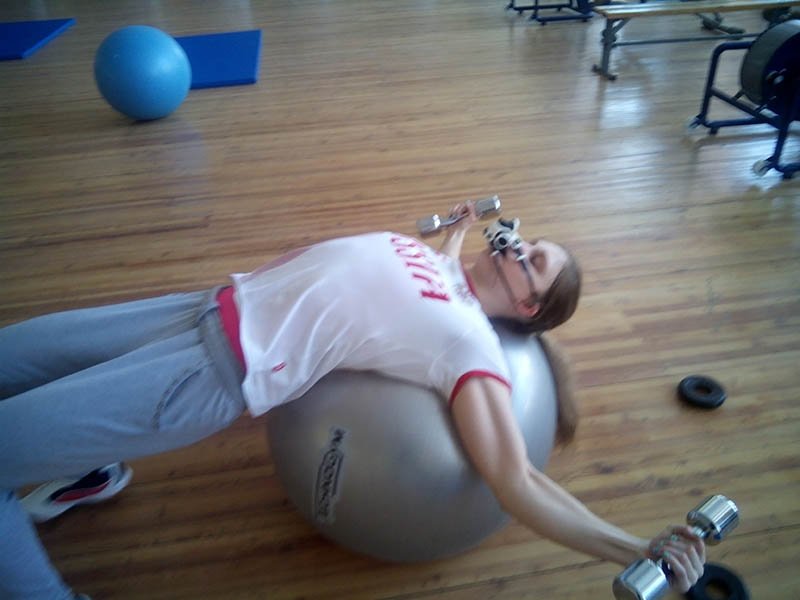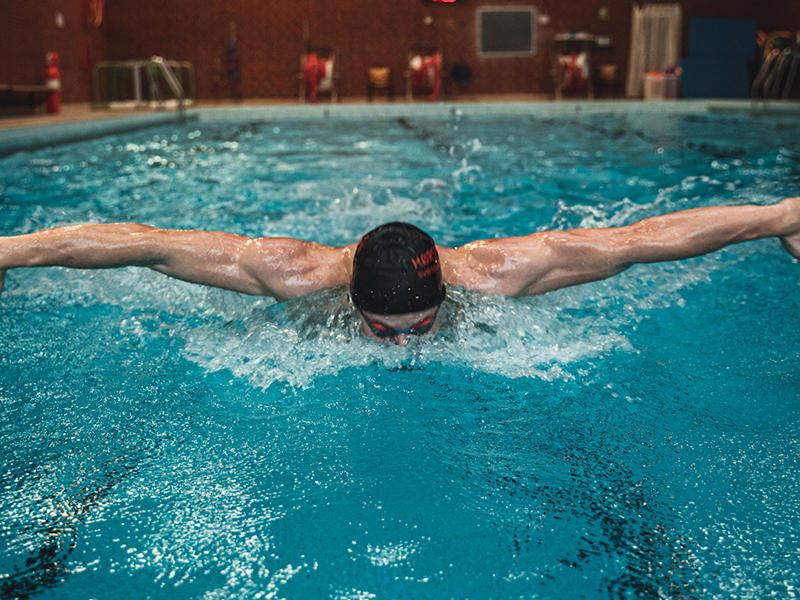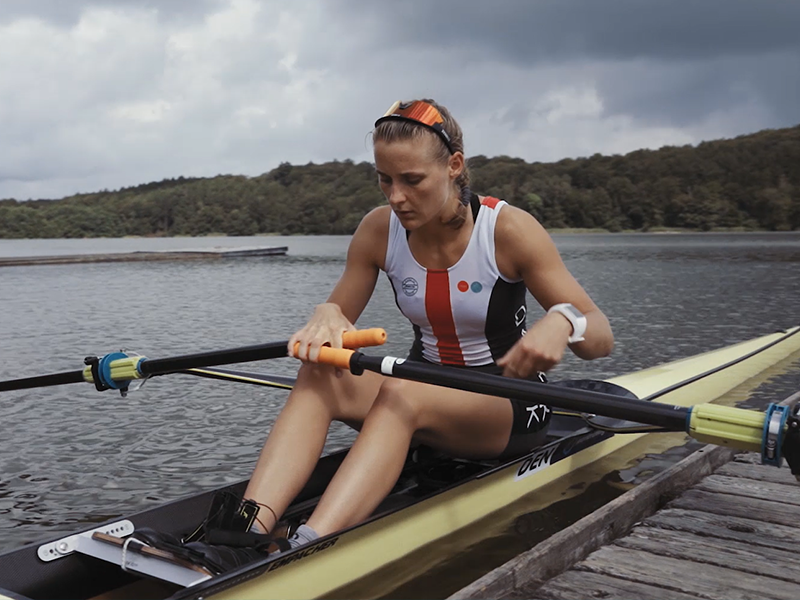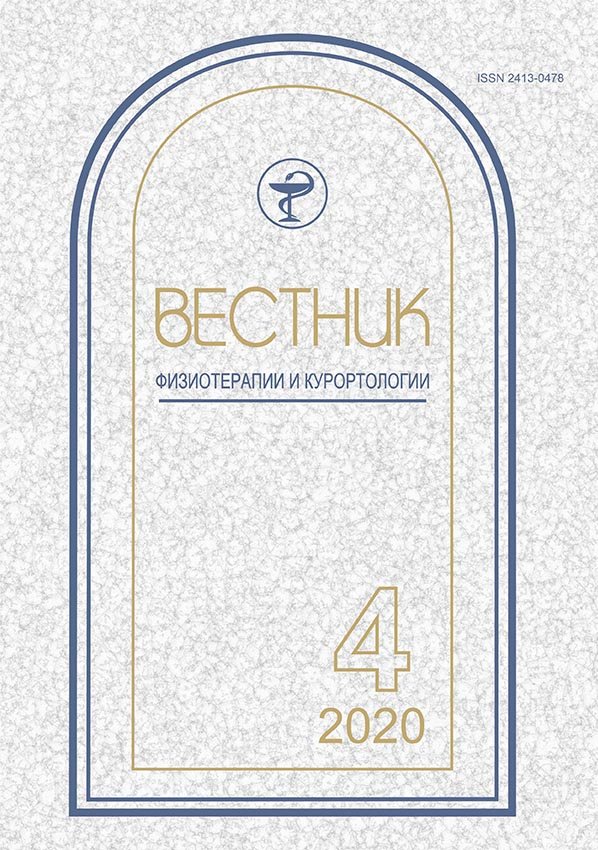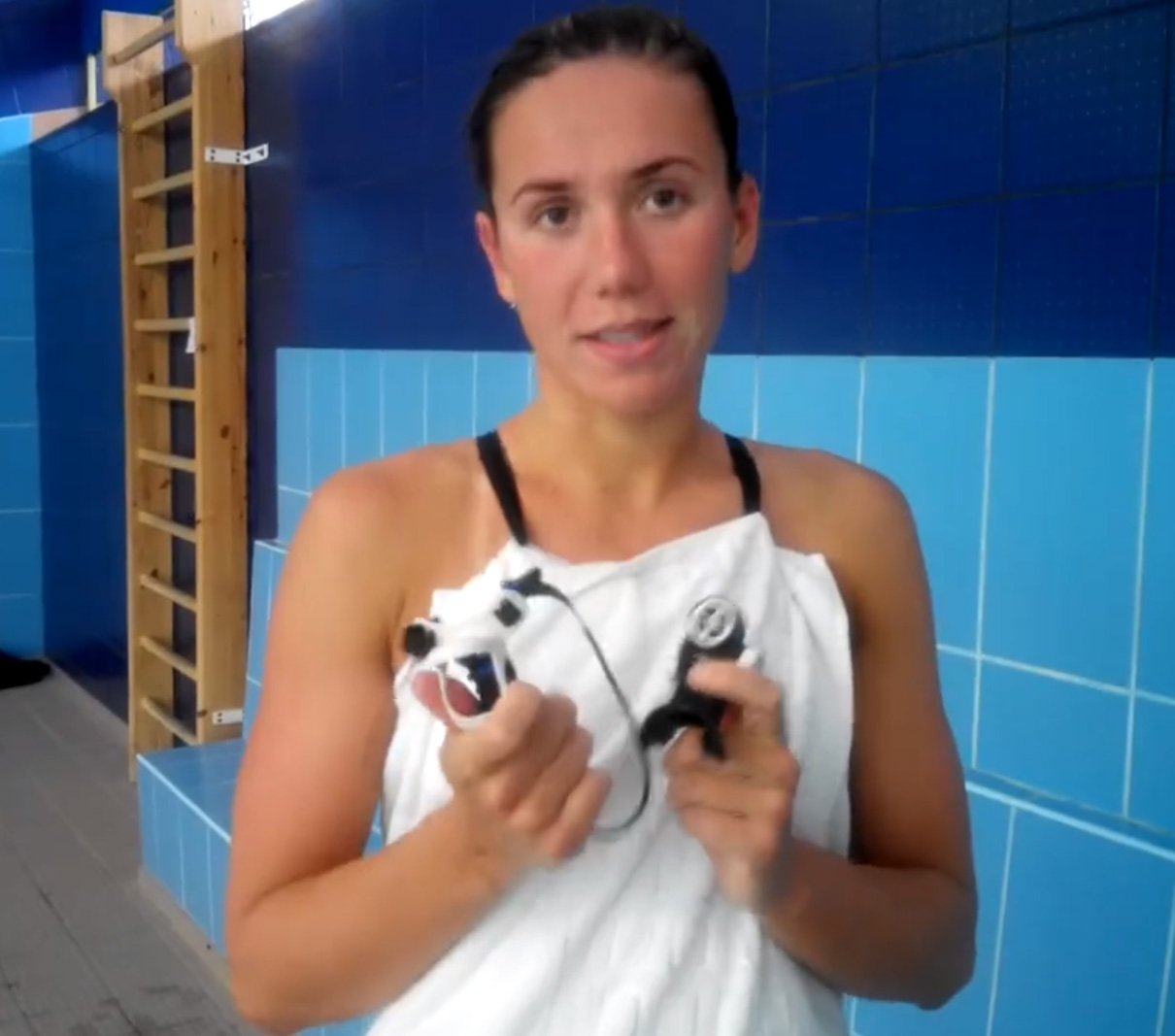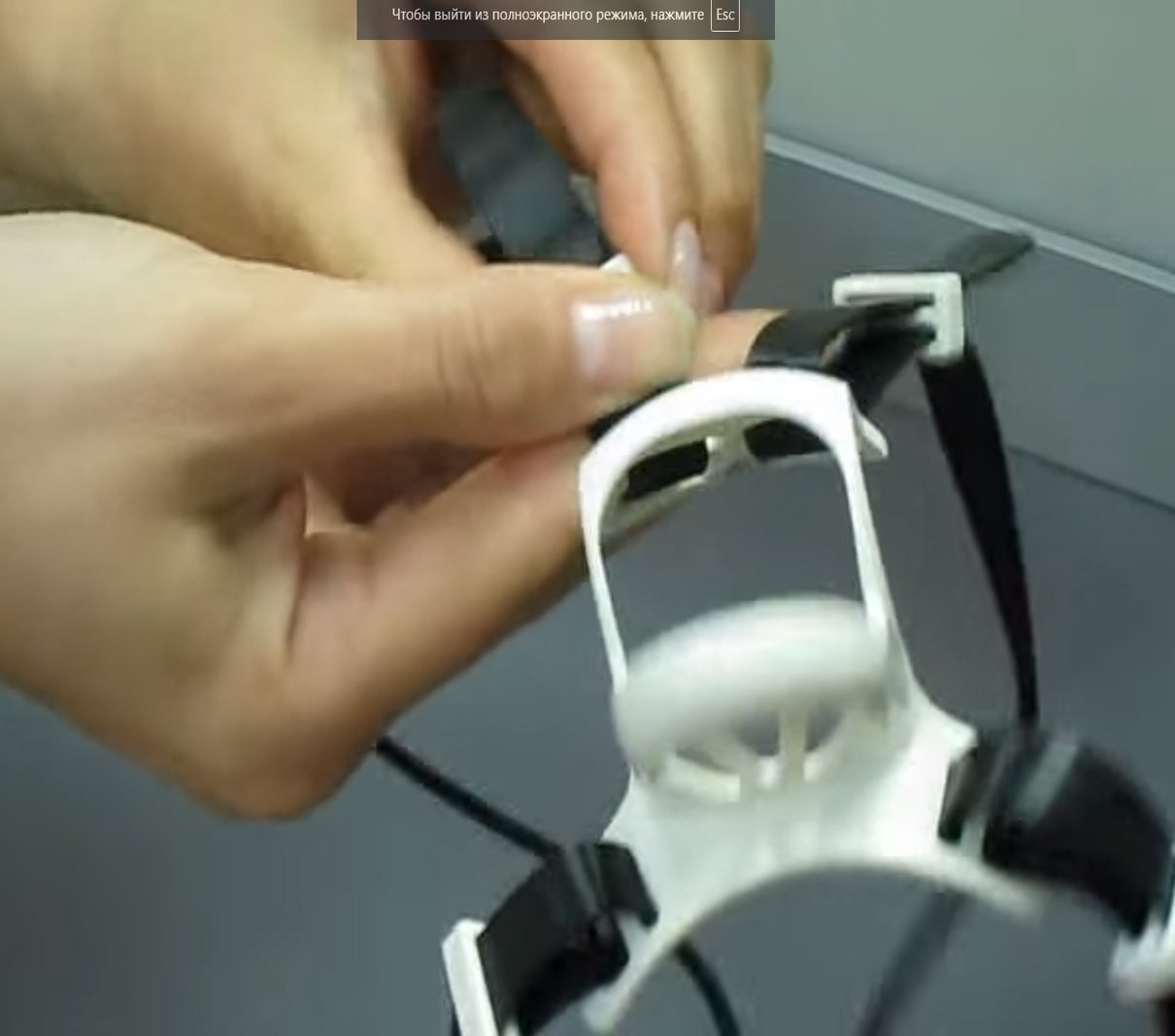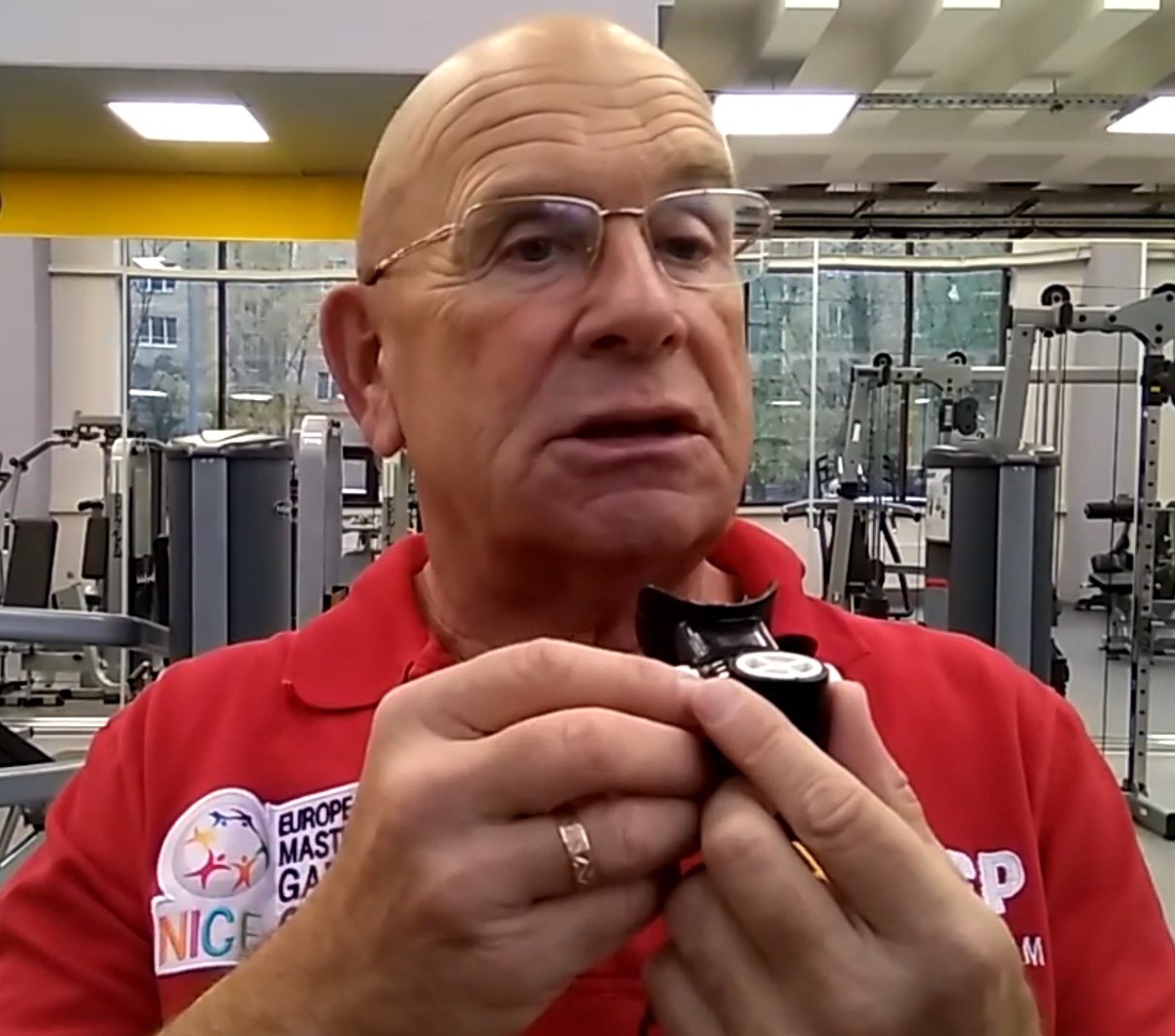Biomechanical background of sportsmen respiratory system training and their implementation experience.
In many types of people’s physical activity, and in many kinds of sport in particular, there is quite a close connection between respiratory movements and body movements and its parts. At that, the disturbance of this connection in some kinds of sport (swimming, rowing, etc.) leads to significant change of biomechanical structure of the movement itself.
The breathing pattern determines these movements’ performance effectiveness, and, on the other hand, respiratory movements(rhythm, frequency and depth) are organized in accordance with the biomechanics of the movement itself.
So, for instance, it is known (Farfell V.,Freidberg V.), that the greatest muscular effort develops when holding breath (straining), a little less – when exhaling, the least – when inhaling. This fact explains why sportsmen try to combine inhaling with power stages of a competitive movement in many kinds of sport. It is also known that physical exercise intensity growth, especially in cyclic kinds of sport, greatly complicates volitional breathing control. The combination of breathing phases with movements can be conditionally characterized as “anatomic” and “biomechanics” ways of breathing.
Anatomic breathing method is realized in movements, where inhaling corresponds to chest capacity enlargement and exhaling causes chest capacity diminution (i.e. morning exercises, warming up exercises, etc.).
Biomechanical breathing method is realized in movements, where exhaling happens in the most muscle-strengthening exercises and inhaling – in relative relaxation stages. Thus, in rowing exhaling happens while paddling and inhaling – while pulling down. Biomechanical method of breathing organization is used in such kinds of sport where movement frequency of relatively low(rowing, swimming, skating, etc.). The higher the movement frequency is, the more difficult it is to realize this method of breathing.
When this happens, almost all vital functional systems of a person(cardiovascular, nervimuscular, immune, blood circulatory, etc.)improve, and respiratory muscles develop without changes in kinematical and dynamic structures of the movement performed.
It is this phenomenon, which is realized neither by Frolov’s exerciser, not by “Samozdrav”, nor by Powerbreathe.
It is known, that untrained respiratory muscles may “steal” up to 70% of oxygen inhaled from the muscles, used in motion act, decreasing its performance effectiveness and the effectiveness of the basic functional body systems’ work.
Thus, “breathlessness” appearance, heart beat frequency increase, blood pressure significant rise while doing exercises, are connected with respiratory muscles development fall.
Respiratory muscles force and fatigue resistance improve by their training or by functioning when there are on-load. Exhaling with resistance to air flow can serve as a load.
When breathing, one should accentuate exhaling, not inhaling. In this case the air, incoming to lungs out of the atmosphere mixes with the less quantity of residual air , where oxygen content is a lot lower and the content of carbon dioxide is a lot higher than in the air inhaled.
While the exercise performance intensity rises, the breathing frequency rises, and the respiration depth lowers. It seems, that it is connected with the fact that signals from activated muscles, but not voluntary control, start to play the main role in breath control.
At the same time respiratory depth is practically directly connected with respiratory muscles activity. Thus, if respiratory depth is 30-40% of lung capacity, diaphragm and inner and outer intercostals muscles are activated. If respiratory depth is 40-65% of lung capacity, major pectorals, pectoral-clavical-mastoidal muscles, scalenus, toothed muscles are activated and if respiratory depth is 65% of lung capacity, almost all pectoral arch muscles and prelum abdominale are activated.
These data may be considered as a guide to action when selecting/choosing training devices for respiratory muscles/respiratory system training of athletes and sportsmen.
Respiratory muscles purpose-oriented training is necessary for sportsmen, athletes and ordinary people. Respiratory system work effectiveness pretty much depends on respiratory muscles development. This is why the basic problem/aim is to develop respiratory muscles for building-up a sound body, where, as you know, there is a sound mind.
At the same time, normal and sporting physiology shows, that physical activity changes both respiratory characteristics and the source of breath control process. That is, the higher the physical exercise performance intensity is, the greater role play “signals”, coming from activated musculotendinous structure and musculoskeletal system in breathing and respiratory muscles work.
When this happens, almost all vital functional systems of a person(cardiovascular, nervimuscular, immune, blood circulatory, etc.)improve, and respiratory muscles develop without changes in kinematical and dynamic structures of the movement performed.
It is common knowledge that respiratory muscles, which are not trained, may “steal” up to 70% of oxygen inhaled from the muscles, used in motion act, decreasing its performance effectiveness and the effectiveness of the basic functional body systems’ work.
Thus, “breathlessness” appearance, heart beat frequency increase, blood pressure significant rise while doing exercises, are connected with respiratory muscles development fall.
|
Strength development and «stamina» of respiratory muscles improve at their training or exercising. Physical exercise for respiratory muscles is an exhalation with resistance to expiratory air flow.
Sporting practice shows that low frequency (16 – 30 Hz) muscles vibrostimulation increases their (muscles) efficiency.
Exhalation with additional load except for load on respiratory muscles results in pressure boost in bronchi and lungs respiratory channel being opened longer than exhalation without resistance even if bronchial paries is loosen or unstable (bronchial collapse). Sputum transportation from paries improve in comparison with exhalation without load.
Exhalation with variable load, frequency being 12 – 30 Hz is resulted in the following processes.
Firstly laminar expiration air flow becomes turbulent – pressure oscillation of expiratory air is set by loading device. In this case bronchi «work» as follows (Fugure 1).
Figure 1. Bronchi «work» scheme with low frequency load to expiratory air flow.

Pressure level changes in respiratory channels induce the same frequency bronchi oscillations. It means that if there is no resistance to exhalation bronchi do not expand (bronchial collapse) (Figure 1.1.).
When exhalation resistance increase pressure also increase and bronchi expand (Figure 1.2). Rapid exhalation resistance decrease results in pressure decrease and bronchi shrink (Figure 1.3). Fast pressure increase expands bronchi again (Figure 1.4). A rapid change in expiratory air flow pressure and contributes to better sputum discharge from bronchial paries and its (sputum) further extraction from lungs (Figure 2).
Figure 2. Sputum «transportation» from lungs at low frequency load to expiratory air flow.

Thus resistance to low frequency expiratory air flow (12 – 30 Hz) enable us to reach the following positive results:
1. Increase load to respiratory muscle to develop their strength and stamina.
2. Keep respiratory channels opened at the exhalation phase preventing bronchial collapse.
3. Enrich inhale and exhalation.
4. Improve sputum transportation and pulmonary ventilation.
5. «Involve» respiratory channels fragments with insufficient aeration into respiratory process.
6. Increase air flow at the end of exhalation phase (increase vital capacity).
7. Suppress tussive reaction.
Existing devices may realize the abovementioned effect and can be used only in permanent position and designed for mucoviscidosis’ treatment and prevention.
At the same time it is common knowledge that physical exercises actively stimulate respiratory muscles activity. It is «afference … with locomotors system proprioceptors that serves as an additional and very important muscles development boost» to provide respiratory system effective performance of a sportsman.
That is why it is reasonable to use devices which can be used during warm-up and at the basic part of training for respiratory muscles development (Golomazov and others, 2001).
The device disadvantage is that the exerciser can’t be used for swimming. At the same time it is common knowledge that swimming is a perfect training for respiratory muscle.
Thus according to Е.S.Sadovnikov (1979) and V.I. Kebkalo (1981, 1988) research «..driving induce lung pulmonary vital capacity reduction for 8- 10%. Respiratory system function in water and its oxygen value 1.5 – 1.8 times as high as similar respiratory regimes on land».
We underline that «combined» exerciser’s effect is very important for sport so that it wouldn’t interfere with your technique. In this case training effect significantly increase.
All things considered, corporate authors of LLC «Sport Technology» developed and produced crucially new unique exerciser for respiratory muscles training on move including training in water «Novoe Dykhanie» (hereafter Exerciser).
Exerciser for respiratory muscles training on move «Novoe Dykhanie» fall into mechanic exercisers category for different ground of muscles training with low frequency mechanic vibration (16 – 30 Hz).
The exerciser functioning is based on simultaneous usage of physical and physiological factors:
- adjustable mechanical resistance to expiratory air flow:
- low frequency vibration of expiratory air flow:
- physical exercises intensification.
Variation and interaction of the factors boosts adaptation effect of a person/sportsman body functional systems adjustment for the chosen activity or sports event as against respiratory exercisers of Frolov and "Samozdrav".
An experimental research was carried out for the exerciser’s effect to sportsmen external respiration.
The research objective was experimental validation of the exerciser application during different sportsmen training.
The research was aimed at:
1. Different sportsmen external respiration peculiarities research in circumstances where exercises load increase with the Exerciser.
2. Sportsmen respiration process comparative analysis conduction in circumstances where exercises are performed at normal respiration with the Exerciser.
3. Elicit prerequisites for the Exerciser application in different sportsmen training.
The results were supposed to be the prerequisites for Exerciser’s technology development in different qualification sportsmen training.
Two groups of sportsmen took part in the research. The first group consisted of 5 sportsmen (age - 19-22, weight 69+/-3.6 kg) specialized in lawn tennis (advanced degree, candidate master). The second group contained nonprofessional participants who were involved in fitness and jogging with 10 – 15 year experience, average age - 30-38, weight 76+/-5.9 kg.
Participants external respiration peculiarities research in circumstances where exercises load increase with the Exerciser and under normal conditions was performed at limited muscle activity of incrementally increasing character «till refusal» of the participant.
The idea was that the participants should perform two limited character exercises on mechanical exerciser «Monarch» under normal conditions and with the Exerciser (hereafter «Mask» and «Exerciser»). «Mask» variant is an exercise with a gas mask put on without additional expiratory air flow resistance. «Exerciser» is an exercise with the Exerciser.
Physical tension remained untouched at different variants of respiration and looked as follows.
After two minutes of expiratory air and blood sampling (initial condition) seated on bicycle ergo meter the participant performed incrementally increasing exercise «till refusal» with one of the respiration variants. Initial load was 240 kgm/min (40 Wt; 0,5 кР).
Cycling tempo was constant during the whole exercise performance – 80 rotations per minute. It could be recorded by speed counter.
Physical load increase was performed by means of resistance intensification to 240 kgm/min (40 Wt; 0,5 кР) after each two minutes (according to recommendations of Astrand P.O. et al., 1977; Golovachev A.I., 1998).
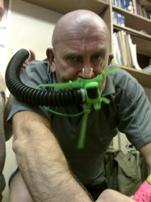 Each 15 seconds after physical loads performance at different respiratory modes the following parameters were registered: cardiac rate (CDR) and cycling rate (CR) were recorded by means of specialized sport tester S 725 (Finland), lactate concentration at the end of each work stage after stops and on the 3-rd rehabilitation minute as well as external respiration parameters at the end of each minute and rehabilitation (within the first 3 minutes) within 30 seconds. Each 15 seconds after physical loads performance at different respiratory modes the following parameters were registered: cardiac rate (CDR) and cycling rate (CR) were recorded by means of specialized sport tester S 725 (Finland), lactate concentration at the end of each work stage after stops and on the 3-rd rehabilitation minute as well as external respiration parameters at the end of each minute and rehabilitation (within the first 3 minutes) within 30 seconds.
A special mask equipped with a crossover valve was attached to participants to make an air intake. The Exerciser could also perform air intake by means of specially developed assembly which was connected to the crossover valve. Gases concentration analysis in expiratory air (after sampling into Douglas bag) was carried out in gasometrical analyzer «Beckman» (USA) ОМ-II and LB-2 for %О2 and %СО2. Expiratory air volume was detected by means of dry type spirometer «Oxymer» (Germany).
It is necessary to remark that every next analysis of different respiratory modes research was carried out in terms of three days taking into account time for glycogenous recovery (Volkov N.I., 1969).
The recorded parameters provided not only sportsmen external respiration peculiarities research but also main power supply systems activity results.
During each exercise performance («Mask» and «Exerciser») the following external respiration and work parameters were analysed:
Тр - exercise work time, min;
Nmax - maximum power (kgm/min);
Nmax/kg - maximum power work comparative to a sportsman unit weight (kgm/min/kg);
МOC - maximum oxygen consumption, absolute (l/min) and comparative (ml/min/kg) parameter;
МLV - maximum lungs ventillation, l/min;
OUC2 - oxygen utilization coefficient, %;
%СО2 - carbon dioxide percentage in expiratory air, %;
RC - respiratory coefficient;
Lactate - lactate concentration in blood, mM/l;
О2-debt - «alact» oxygen debt faction, l;
CDR - cardiac rate, b/min;
OP - oxygen pulse, ml/b;
NАТ - anaerobic limit power, kgm/min/kg;
VO2АТ - oxygen consumption, АТ level, ml/min/kg;
CDRAT - cardiac rate, АТ level, b/min;
Research results and their discussion
In order to correctly realize external respiration peculiarities using the Exerciser we remind that the Exerciser’s base is a special work load device which produces low frequency vibration at exhalation in combination with adjustable resistance.
For that matter we could expect differences in comparative analysis of В связи с этим мы были вправе ожидать проявления различий при динамики pulmonary ventilation dynamics of both participating groups that was testified by the research results (Figure.3, 4).
It was underlined that the Exerciser application reduces pulmonary ventilation volume at the power increase due to the Exerciser’s design features.
Participants’ level of training and motor activity specific character has a significant influence on the exercise duration.
Thus the 1-st group participants refused to carry out exercise on the 12-th minute what equals to 480 Wt, the 2-nd group participants «refused» to proceed on the 8-th minute – 320 Wt.
Pulmonary ventilation differences in the 1-st group were recorded at the 4-th minute (2-nd load stage) which were equal to 5.55 l/min (-14.2%).
The differences in the 2-nd group were recorded only at the 6-th minute – 5.4 l/min (-10.2%).
Pulmonary ventilation differences between breathing with and without resistance in the 1-st group increase after the 4-th minute and were 45,6% or 52,0 l/min.
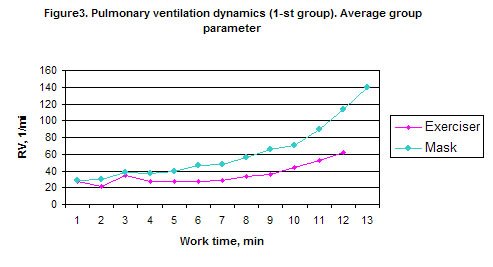
The 12-th minute of the exercise corresponded to the moment. At that pulmonary ventilation perameter working with the Exerciser was 62,0 l/min and breathing in mask - 141,0 l/min (Figure. 3). Pulmonary ventilation difference parameter in the 2-nd group on the moment of «refusal» (the 8-th minute) was 20.4% or 15, 4 l/min. At that pulmonary ventilation parameter with the Exerciser was 61.6 l/min and with mask– 76 l/min.
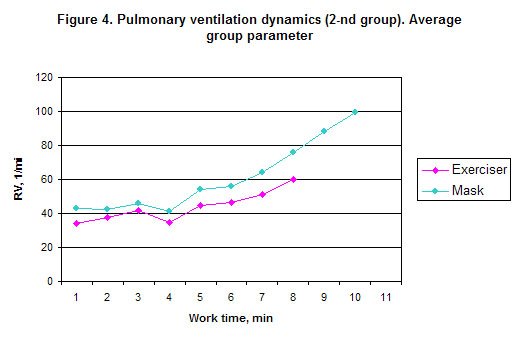
It is necessary to mention that in case of unloading pulmonary ventilation in the 2-nd group reduced much faster than in the 1-st and was recovered less on the 3-rd minute than in the beginning of the experiment.
The Exerciser influence to oxygen utilization coefficient dynamics OUC2 (Figure 5 and 6).
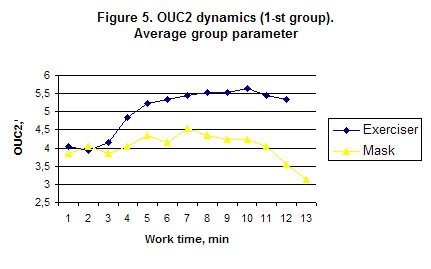
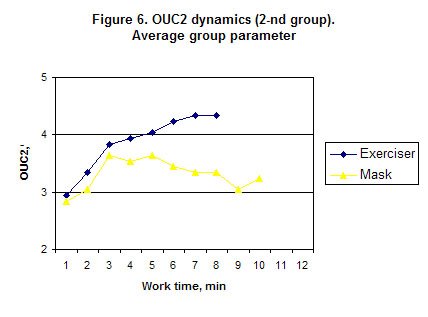
Figure 5 shows that differences in OUC2 in the 1-st group with the Exerciser can be seen since the 3-rd minute (2-nd load stage). Then you may see a fast OUC2 growth till the 5-th minute of the exercise (3-rd load stage) where the parameter difference may reach 16.3 % (at OUC2 - 5.2% and 4.3% for «Exerciser» and «Mask» respectively). OUC2 slow growth proceed up to 10-th minute (end of the 5-th load stage) when differences reach 33% (OUC2 parameters 5.6% and 4.2% for «Exerciser» and «Mask» respectively). Then OUC2 parameters for «Exerciser» variant reduce till the moment of «refusal» (the 12-th minute, 6-the load stage). Differences in this parameter at the moment of «refusal» equal 51.2% (OUC2 parameters 5.3% and 3.5% for «Exerciser» and «Mask» respectively).
Figure 6 shows that the 2-nd group participants’ OUC2 parameters are less than the 1-st group participants’ ones. This shows a connection between sportsmen level of training and OUC2. This factor apparently effects dynamic of research characteristic on the first minutes of the exercise (Figure 6). Parameters differences between «Mask» and «Exerciser» variants can be seen only at the end of the 2-nd load stage (the 4-th minute) and equal 11.4% (OUC2 parameters 3.9% and 3.5% for «Exerciser» and «Mask» respectively). Then OUC2 rate of growth reduce but the parameter still growth till «refusal» where differences are 30.3% (OUC2 parameters 4.3% and 3.3% for «Exerciser» and «Mask» respectively).
Carbon dioxide percentage in expiratory air %СО2 in both groups is given in Figures 7,8.
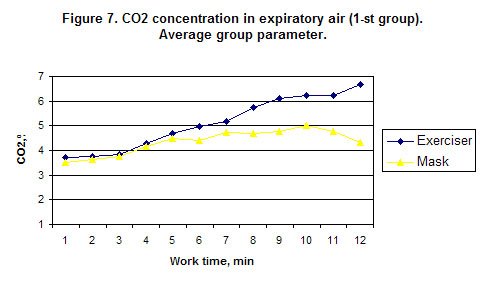
According to the illustration it is clear that the feature dynamics is almost the same in both groups. However absolute values of %СО2 are higher with the second group participants.
It should be noted that differences in OUC2 and %СО2 in both groups between «Mask» and «Exerciser» variants increase by the 7-th – 8-th minute (the 4-th load level) what corresponds to introduction into anaerobic limit zone when the Exerciser prevent a sportsman from pulmonary ventilation volume increase.
At the same time the following results were shown in the 1-st group. If %СО2 dynamic remained the same OUC2 parameters increase proceed till the10-th minute (the 5-th load stage), and then reduce.
Since this moment respiratory coefficient RC growth was registered in the 1-st group (Figure 9). RC parameter rise sharply on the 11-th minute (since 1.11 on the 10-th minute till 1.25 on the 12-th minute). Difference between variants
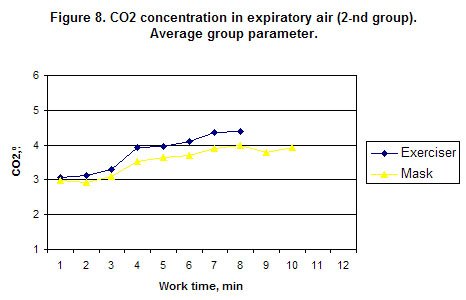
«Mask» and «Exerciser» on the 10-th minute was 9.9% and 17.9% - on the 12-th minute.
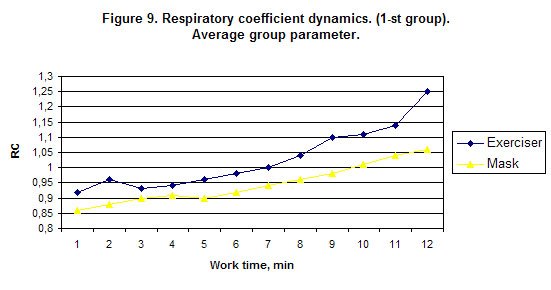
Findings on RC dynamics for the 1-st group during exercise and recovery period testify to a more progressive «acidification» of sportsmen body when working with the Exerciser.
Thus when training with the Exerciser RC level exceeding parameter 1.0 can be reached on the 7-th minute and training with the «Mask» - only on the 10-th (Figure 9).
RC dynamics in the 2-nd group is given in Figure 10. It is clear that working with the Exerciser RC parameter almost equals to 1 (0.99) and it was reached on the 6-th minute. The same parameter for «Mask» variant can be reached on the 10-th minute. It means that working with the Exerciser «acidification» of the 2-nd group participants’ body took place prior to the 1-st group sportsmen.
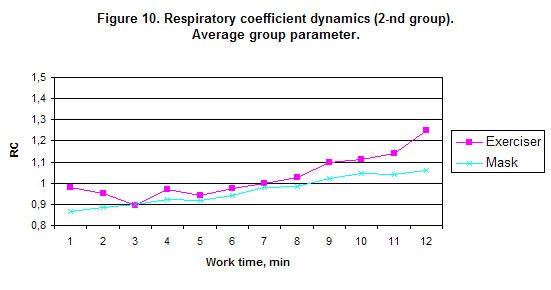
As is clear from Figures 11, 12 oxygen consumption dynamics is the same in both groups. MOC in «Exerciser» variant is less than in «Mask». However the following differences were revealed.
Firstly MOC absolute values in the 1-st group are higher than in the second one. Secondly the differences in the first group were noticed on the 3-rd minute (the 2-nd load stage), and in the second group – on the 4-th minute (the end of the second load stage).
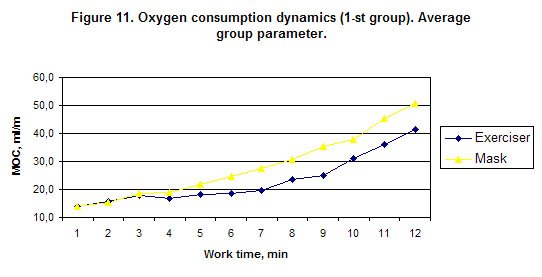
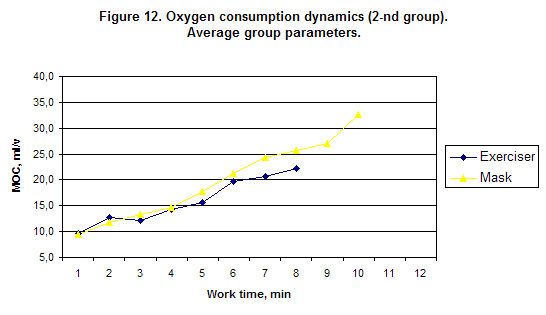
The findings testify that respirations with the Exerciser results in oxygen consumption reduction and as a consequence oxygen utilization coefficient increase.
Cardiac rate dynamics in both groups is reflected in Figures 13, 14.
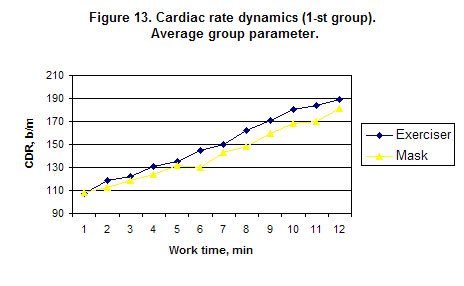
Figure 13 shows that cardiac rate till the 5-th minute (beginning of the 3-rd load stage – 60 Wt) almost the same for both variants – «Mask» and «Exerciser». Later on if work load increase, CDR is higher when working with the Exerciser than under normal conditions («Mask» variant) till the 11-th minute (the 6-th load stage) and by «refusal» moment (the 12-th minute, the end of the 6-th load stage, 240 Wt) CDR for both variants is the same.
CDR dynamics in the second group is totally different.
Since the 1-minute CDR when working with the Exerciser is much (for 9.1%) higher than exercise under normal conditions. Differences were noted during the whole exercise process. On the moment of «refusal» (the 8-th minute, the 4-th load stage) difference in parameter equals 9.4%.
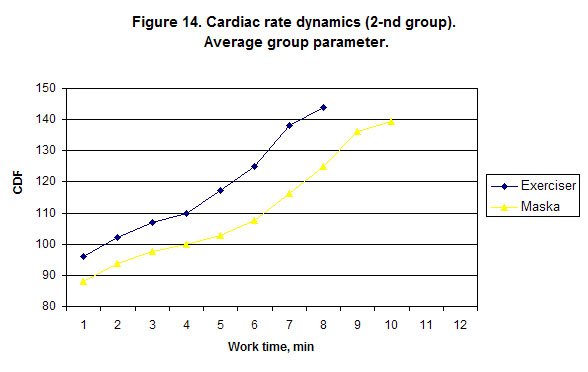
Figure 14 shows that «pulse work value» with the Exerciser is lower than under normal conditions.
As far as work with the Exerciser at the load level of 40 Wt corresponds to work under normal conditions at the load level of 80 Wt and CDR equals 110 – 112 b/min. Work at the pulse of 140 b/min corresponds to load level of 160 Wt (Exerciser) and 200 Wt (Mask) (Figure 14).
According to the results we may suggest that trainings with the Exerciser gives higher activation to cardiovascular system functioning at a standard load.
Lactate dynamics research (Figure 15, 16) showed that since first standard load stages in both groups with the Exerciser its (lactate) value was higher than under normal conditions.
However in the 1-st group on the 4-th minute lactate value in «Exerciser» variant less than in «Mask» variant (1.26 and 1.34 mM/l respectively). In the 2-nd group on the 4-th minute lactate values for «Mask» and «Exerciser» are the same – 0.9 mM/l. Other determination showed that lactate values in both groups with the «Exerciser» are higher than in «Mask» variant.
Lactate values difference at the moment of «refusal» in the 1-st group was 0.3 mM/l or 4.3%. And 0.3 mM/l for the 2-nd group but it corresponds to 16.7%.
The experiment findings testify that the Exerciser application in relation to a normal respiration process results in maximum anaerobic performance reduction and in a high accumulation speed on standard load levels (below and on anaerobic limit level. It means that the Exerciser application contributes to earlier creation of hypoxia (artificial controlled hypoxic environment).
Take notice that a lack of free oxygen during muscle work under standard load stages prevent current lactic acid from oxidation to carbon dioxide and water as far as its supply is limited by ingoing air volumes (pulmonary minute volume) and this lack can’t be replenished by oxygen utilization coefficient and cardiac rate growth .
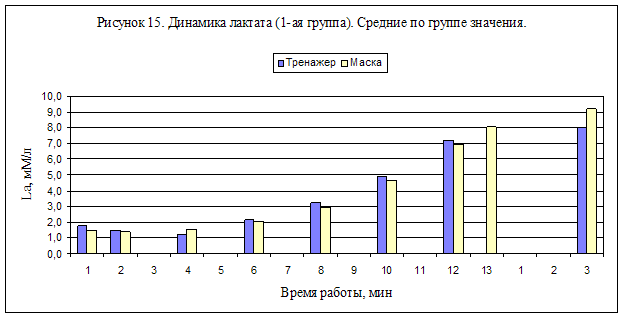
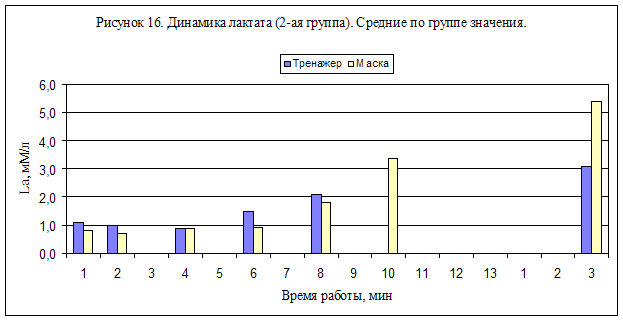
Final results
On the whole the research showed that the main limiting factor of muscle work interruption is insufficient volume (as pulmonary ventilation) which limits respiratory system abilities to participate in the oxygen consumption process. However it should be noted that the whole complex of parameters gives the reason to suggest that the Exerciser application for different muscle work contributes to creation of artificial hypoxic environment (look respiratory coefficient dynamics and lactate concentrate on «standard» load stages under normal conditions and with the Exerciser application).
Summary
1. The research results show that in comparison with the normal respiratory process the Exerciser application results in significant limitation of expiratory air flow from the beginning of till the very end of load training. It is testified by statistically significant difference in pulmonary ventilation parameters in spite of sportsmen qualification.
2. Insufficient volume of ingoing air into the sportsman body (as a result of pulmonary ventilation limitation) with the Exerciser contributes to significant increase in carbon dioxide concentration and in oxygen utilization coefficient. At the same time there is no increase in oxygen utilization coefficient equivalent to carbon dioxide volume. It means that respiratory coefficient is over 1,0.
3. Oxygen consumption dynamic research results testify that respiration with the Exerciser application results in oxygen consumption reduction (due to insufficient volume of pulmonary ventilation and oxygen utilization coefficient growth).
4. It was found out that respiratory process with the Exerciser contributes to higher activation of cardiovascular system functioning to a standard work load. But it prevents the sportsman from reaching of maximum possible level.
5. Lactate dynamics research results testify that the Exerciser application in relation to a normal respiration process results in maximum anaerobic performance reduction and in a high accumulation speed on standard load levels (below and on anaerobic limit level..
The research results were prerequisites for educational experiment on the Exerciser efficiency development for different qualification gymnasts and sportsmen training. |
|
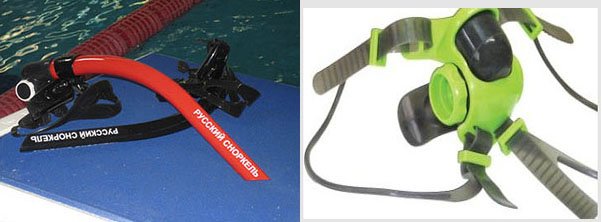








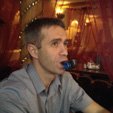
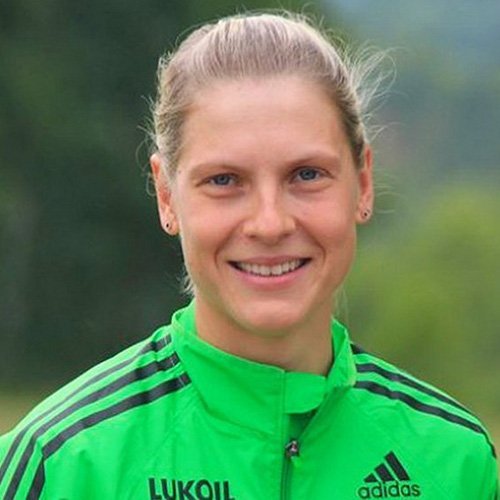
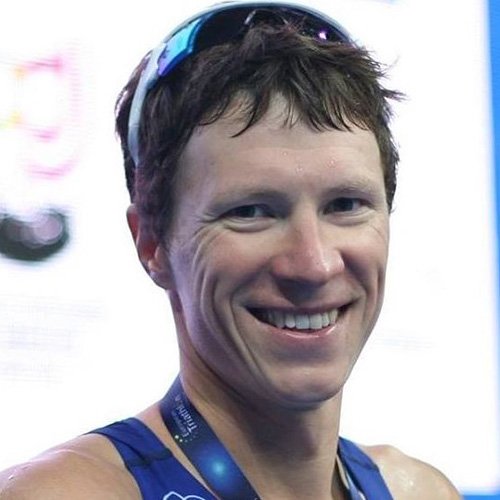
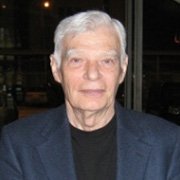







 Each 15 seconds after physical loads performance at different respiratory modes the following parameters were registered: cardiac rate (CDR) and cycling rate (CR) were
Each 15 seconds after physical loads performance at different respiratory modes the following parameters were registered: cardiac rate (CDR) and cycling rate (CR) were















